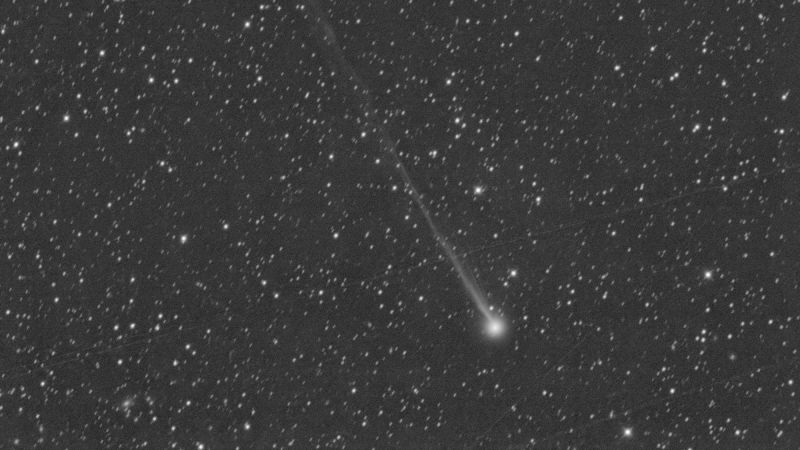When celestial spectacles occur, particularly those involving comets, they often capture the fascination of sky-gazers and astronomers alike. However, the excitement surrounding a newly discovered comet can sometimes lead to bittersweet outcomes, as they may meet a catastrophic end as they approach the Sun. This is exemplified by Comet C/2025 F2, popularly known as Comet SWAN. Recent observations indicate that this comet, characterized by its fuzzy green appearance, has likely disintegrated within a matter of days.
Qicheng Zang, a postdoctoral fellow conducting research in small body astronomy at Lowell Observatory located in Flagstaff, Arizona, shared insights on the situation. He emphasized that the latest observations from ground-based telescopes indicate a probable breakup of the comet. Dr. Karl Battams, a computational scientist working in the Solar and Heliospheric Physics Branch at the US Naval Research Laboratory in Washington, D.C., echoed these sentiments, noting that further observations are essential to conclusively determine whether disintegration is responsible for the comet’s recent outburst and subsequent dimming.
Zang mentioned a remnant dust cloud that should remain visible through telescopes for several weeks. However, the dust is expected to spread out and fade. For those in the Northern Hemisphere, there is a unique opportunity to view the remnants of the comet early in the morning. Prior to its disintegration, the anticipation surrounding the comet was primarily fueled by its recent discovery and the prospect of its closest approach to the Sun on May 1. This presented a rare viewing experience, as it was unlikely to return to our solar system for several hundred thousand years, if at all.
The comet bears the name SWAN as it was monitored by the Solar Wind ANisotropies (SWAN) instrument aboard the Solar and Heliospheric Observatory (SOHO), a collaborative mission between the European Space Agency (ESA) and NASA. Amateur astronomers from various locations, including Vladimir Bezugly from Ukraine, Michael Mattiazzo in Australia, and Rob Matson in the United States, independently discovered the comet by examining images captured by the SWAN instrument. The Minor Planet Center officially classified this celestial object as C/2025 F2 (SWAN) on April 8.
In terms of discovery, the astronomers observed a faint smudge across the sky that changed position over several days. Dr. Battams noted that since there were no comets previously recorded in that region, they correctly identified this smudge as a newly discovered comet. He serves as the principal investigator for the Large Angle and Spectrometric Coronagraph instrument suite on the SOHO spacecraft, which captures images of the Sun’s atmosphere.
For those wanting to observe the comet’s remnant, Battams recommends looking low towards the northeast horizon a couple of hours before dawn. He also pointed out that visibility will be confined to the Northern Hemisphere until early May, after which the comet will transition to southern hemisphere skies. With its initial brightness waning during recent days, astronomers now recognize that this dimming likely indicates the comet’s impending fate.
The slight drop in brightness prior to the comet’s disintegration was an early warning sign. Zang suggested that the surge in brightness following its discovery likely signified the moment it began to break apart. As the comet fragments, the ice inside becomes exposed to sunlight, transitioning into gas, which accounts for the brilliant green glow observed. However, as the ice depletes, the gas release slows, leading to a gradual dimming.
Astronomers believe that Comet SWAN originated in the Oort Cloud, a distant repository of icy debris on the outskirts of our solar system. Battams expressed that such comets occasionally experience gravitational nudges that propel them toward the sun, and this particular comet has been on its inward journey for roughly 35,000 years. Recent reports indicate that it completes one full orbit around the sun every 2.1 million years.
As comets approach the Sun, the increasing heat triggers the release of gas and dust, forming their characteristic tails. Larger, heavier comets typically withstand this process without disintegration, whereas smaller comets, like C/2025 F2 (SWAN), are more susceptible. The extreme solar radiation from the Sun ultimately proved too much for this comet, leading to its fragmentation.
Only last October, a separate comet referred to as the “Halloween comet,” officially known as Comet C/2024 S1 (ATLAS), disintegrated during its closest solar approach. It reached a proximity of about 850,000 miles to the Sun—known as a sungrazer comet. C/2025 F2 (SWAN) will also pass relatively close to the Sun, being approximately 31 million miles (50 million kilometers) away in May.
The remnants of Comet SWAN will become visible within the constellation Andromeda in the early morning hours, before briefly becoming more apparent in the night sky as April concludes. A new moon



